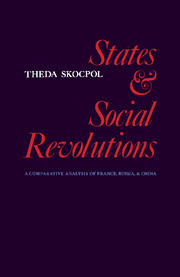Book contents
- Frontmatter
- Dedication
- Contents
- List of Tables and Maps
- Preface
- Introduction
- Part I Causes of Social Revolutions in France, Russia, amd China
- 2 Old-Regime States in Crisis
- 3 Agrarian Structures and Peasant Insurrections
- Part II Outcomes of Social Revolutions in France, Rusia, and China
- Conclusion
- Notes
- Bibliography
- Index
2 - Old-Regime States in Crisis
Published online by Cambridge University Press: 05 August 2014
- Frontmatter
- Dedication
- Contents
- List of Tables and Maps
- Preface
- Introduction
- Part I Causes of Social Revolutions in France, Russia, amd China
- 2 Old-Regime States in Crisis
- 3 Agrarian Structures and Peasant Insurrections
- Part II Outcomes of Social Revolutions in France, Rusia, and China
- Conclusion
- Notes
- Bibliography
- Index
Summary
For a revolution to break out it is not enough for the “lower classes to refuse” to live in the old way; it is necessary also that the “upper classes should be unable” to live in the old way.
LeninSocial revolutions in France, Russia, and China emerged from specifically political crises centered In the structures and situations of the old-regime states. The events of 1787–9 in France, of the first half of 1917 in Russia, and of 1911-16 in China not only undermined autocratic monarchical regimes but also disorganized centrally coordinated administrative and coercive controls over the potentially rebellious lower classes. The revolutionary crises developed when the old-regime states became unable to meet the challenges of evolving international situations. Monarchical authorities were subjected to new threats or to intensified competition from more economically developed powers abroad. And they were constrained or checked in their responses by the institutionalized relationships of the autocratic State organizations to the landed upper classes and the agrarian economies. Caught in cross-pressures between domestic class structures and international exigencies, the autocracies and their centralized administrations and armies broke apart, opening the way for social-revolutionary transformations spearheaded by revolts from below.
To understand the nature and causes of the political crises that launched the French, Russian, and Chinese Revolutions we need a sense of the structures of the Old Regimes and of the conflicts to which they were prone in the times before the outbreaks of the Revolutions.
- Type
- Chapter
- Information
- States and Social RevolutionsA Comparative Analysis of France, Russia and China, pp. 47 - 111Publisher: Cambridge University PressPrint publication year: 1979
- 1
- Cited by



